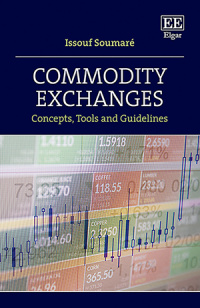Hardback
Commodity Exchanges
Concepts, Tools and Guidelines
9781800887039 Edward Elgar Publishing
Commodities are basic goods used in commerce and are most often used as inputs in the production of other semi-finished or finished materials. They are very important products in our lives today and constitute non-negligible sources of income for many countries. This book serves as a guide to the marketing of these goods and provides scholars and commodity market participants with useful concepts, tools and guidelines to better organize and operate commodities exchanges.
More Information
Critical Acclaim
Contents
More Information
Commodities are basic goods used in commerce and are most often used as inputs in the production of other semi-finished or finished materials. They are very important products in our lives today and constitute non-negligible sources of income for many countries. This book serves as a guide to the marketing of these goods and provides scholars and commodity market participants with useful concepts, tools and guidelines to better organize and operate commodities exchanges.
Issouf Soumaré explains in detail commodities exchanges, from conceptualization of the exchange to its operationalization. He describes the architecture of a typical commodities exchange, looking at its trading and clearing functions, the warehouse receipt system and the regulatory framework. The book also presents practices of commodities exchanges around the world and discusses commodity products and instruments traded on these exchanges, their pricing and usage. This book is very useful and timely, as many emerging countries are setting up commodities exchanges.
Academics interested in commodities and their marketing as well as industry professionals such as commodity traders, commodity exporters, risk managers, clearing officers, market makers, commodity producers, agricultural cooperatives, commodity processors, bankers, warehouse operators, and regulators will find this a useful reference.
Issouf Soumaré explains in detail commodities exchanges, from conceptualization of the exchange to its operationalization. He describes the architecture of a typical commodities exchange, looking at its trading and clearing functions, the warehouse receipt system and the regulatory framework. The book also presents practices of commodities exchanges around the world and discusses commodity products and instruments traded on these exchanges, their pricing and usage. This book is very useful and timely, as many emerging countries are setting up commodities exchanges.
Academics interested in commodities and their marketing as well as industry professionals such as commodity traders, commodity exporters, risk managers, clearing officers, market makers, commodity producers, agricultural cooperatives, commodity processors, bankers, warehouse operators, and regulators will find this a useful reference.
Critical Acclaim
‘This is an important and timely book. Many developing countries are establishing commodity exchanges and there are high hopes on using these market structures to improve the efficiency of the agricultural markets. This book provides a very comprehensive view of the question of commodity markets – across the world and across time. It is a valuable addition to the literature and policy makers, academics and students will discover a wealth of knowledge and information in this great book.’
– Yaw Nyarko, New York University, US
– Yaw Nyarko, New York University, US
Contents
Contents: Preface PART I COMMODITIES MARKETS 1. Commodities: definition, classification and markets 2. Renewable commodities 3. Non-renewable commodities PART II COMMODITIES EXCHANGE: ECOSYSTEM AND ORGANIZATION 4. Commodities exchanges around the world 5. Economic value of commodities exchanges 6. Commodities exchange architecture 7. Warehouse receipt system, commodity storage and product quality control 8. Stakeholders and key participants in a commodities exchange PART III COMMODITIES EXCHANGE: MARKETS, INSTRUMENTS AND FINANCING MECHANISMS 9. Commodity spot and physical markets 10. Commodity forward and futures markets 11. Commodity derivatives markets 12. Financing mechanisms for the agricultural sector and sovereign funds PART IV COMMODITIES EXCHANGE: CLEARING, RISK MANAGEMENT, GOVERNANCE AND REGULATION 13. Clearing house and central counterparty (CCP) 14. Risk management 15. Governance and regulatory issues 16. Useful guidelines for a successful commodities exchange Index




